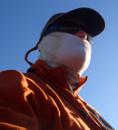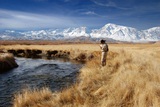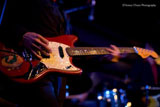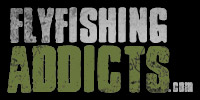When it happens, it is memorable.
I can recall at least a half-dozen times on various waters.
The fish caught generally are 10-16 inches. Lots of time I am nymphing with a 5X tippet and maybe 10-15 feet of line. The water is generally only 2-3 feet deep.
Suddenly, the water explodes. A surprise fish in the 20-inch (plus) size is found. Any hookups are short and the fish seldom get landed.
What do you suggest to land a fish under those circumstances?
Ants
REALTIME FLOWS  U. Kern: n/a cfs
U. Kern: n/a cfs
 L. Kern: 1341 cfs
L. Kern: 1341 cfs
 E.W: 312 cfs
E.W: 312 cfs
 U. Owens: 108 cfs
U. Owens: 108 cfs  L. Owens: 496 cfs 09/02/19 1:15 PM PST
L. Owens: 496 cfs 09/02/19 1:15 PM PST
The Water Explodes - how to land that fish
12 posts
• Page 1 of 1
The Water Explodes - how to land that fish
Initially I would want to know what what Ants do?
Take a deep breath, make sure drag is not too tight. Let the fish run keep tension on line but don’t horse the fish. Hopefully you have a net with you and see if you can get the fish into a spot to net it.
I remember catching 3lb trout on Upper Kern on 5x worried the whole time about losing it. I chased it downstream to net it once it went into shallower water.
Caught a handful of 2-3lbs at Upper Owens and Fall River in Bend all with 5x and trying not to freak out.
I remember chasing down a 6-8lb carp for DRay on LAR, I think he had 4x tippet and had spool seized up. I ran and slipped my way downstream to net it.
A month ago I lost 2 carp on 10lb test. Fluorocarbon broke off on both.went back to Mono after that.with carp I have to be careful not to horse the fish after 5 minutes of a fight.
Sent from my iPhone using Tapatalk Pro
Take a deep breath, make sure drag is not too tight. Let the fish run keep tension on line but don’t horse the fish. Hopefully you have a net with you and see if you can get the fish into a spot to net it.
I remember catching 3lb trout on Upper Kern on 5x worried the whole time about losing it. I chased it downstream to net it once it went into shallower water.
Caught a handful of 2-3lbs at Upper Owens and Fall River in Bend all with 5x and trying not to freak out.
I remember chasing down a 6-8lb carp for DRay on LAR, I think he had 4x tippet and had spool seized up. I ran and slipped my way downstream to net it.
A month ago I lost 2 carp on 10lb test. Fluorocarbon broke off on both.went back to Mono after that.with carp I have to be careful not to horse the fish after 5 minutes of a fight.
Sent from my iPhone using Tapatalk Pro
Rasputinj
- Rasputinj
- Posts: 543
- Joined: October 8th, 2011, 9:06 pm
Re: The Water Explodes - how to land that fish
I think it's what you do beforehand is what increases your chances of landing that fish, and there's a lot of luck involved after the fish is hooked that you cannot control.
I have a habit of not re-tying and checking my knots, especially when the bite is slow. I can't count the number of times I've spent all morning and afternoon flogging the water, and I finally get a good bite at 4 pm and I set the hook only to have the fly-less fly line sail right past my face because the knots I tied at 8 am had become weak and I either broke off at the fly, or the tippet/leader connection.
I fished the Madison in Yellowstone in October a few years ago, and I managed to leave all my 4x and 3x tippet at home, and had spools of only 5x and 6x on me. Apparently, I had caught the river at the time where the big rainbows from Hegben had swam up. On one of my first few drifts, my indicator hesitates suddenly, and I set the hook. And a 24" rainbow rockets from up the depths.

This wasn't your typical rainbow I was accustomed to.
I was running a Hatch 4+ whose drag is pretty good, and the fish took off on a blistering run all the way through my backing. (First time I've seen that since it was installed.) The drag was set perfectly as to give the fish ample room to run if it needed to, and ample braking to prevent it from doing whatever it wanted. The knots had just been tied, and I'm OCD when it comes to them, and the leader material I use I have the upmost confidence in.
When trying knots, if the knot isn't laying down the way I want, I will snip off and try again. I had scouted the general area and had a good idea on where the most amount of current was, and where there was some slack water. I also knew where I could step and not step, if I had to make moves upstream or downstream.
For the first time ever, I realized that having my rod straight up couldn't get me much leverage on turning the fish's head. That is when I soon discovered the 'side pull' and got the fish's head turned, and headed towards the slack water that I had already found before I had made my first casts.
I mentioned 'luck' being a big variable in landing these larger than average fish, and luckily, I had no clear obstructions (rocks, fast water, downed timber, etc) so I was fighting the fish in open water. Of course, having a trusty Sierra Net's net at my disposal assisted in the final landing.
I hooked half a dozen fish that size that trip, all on 5x. Definitely a trip to remember.
Remember those knots, quality line, and sharp hooks. Increasing your odds with the variables you can control always helps. When you do hook up with that 'fish of the trip,' it's your only connection to you and that fish, because once you're hooked up, you can't do much but hope the preparation made before that cast was enough, and hope Lady Luck is on your side.
I have a habit of not re-tying and checking my knots, especially when the bite is slow. I can't count the number of times I've spent all morning and afternoon flogging the water, and I finally get a good bite at 4 pm and I set the hook only to have the fly-less fly line sail right past my face because the knots I tied at 8 am had become weak and I either broke off at the fly, or the tippet/leader connection.
I fished the Madison in Yellowstone in October a few years ago, and I managed to leave all my 4x and 3x tippet at home, and had spools of only 5x and 6x on me. Apparently, I had caught the river at the time where the big rainbows from Hegben had swam up. On one of my first few drifts, my indicator hesitates suddenly, and I set the hook. And a 24" rainbow rockets from up the depths.

This wasn't your typical rainbow I was accustomed to.
I was running a Hatch 4+ whose drag is pretty good, and the fish took off on a blistering run all the way through my backing. (First time I've seen that since it was installed.) The drag was set perfectly as to give the fish ample room to run if it needed to, and ample braking to prevent it from doing whatever it wanted. The knots had just been tied, and I'm OCD when it comes to them, and the leader material I use I have the upmost confidence in.
When trying knots, if the knot isn't laying down the way I want, I will snip off and try again. I had scouted the general area and had a good idea on where the most amount of current was, and where there was some slack water. I also knew where I could step and not step, if I had to make moves upstream or downstream.
For the first time ever, I realized that having my rod straight up couldn't get me much leverage on turning the fish's head. That is when I soon discovered the 'side pull' and got the fish's head turned, and headed towards the slack water that I had already found before I had made my first casts.
I mentioned 'luck' being a big variable in landing these larger than average fish, and luckily, I had no clear obstructions (rocks, fast water, downed timber, etc) so I was fighting the fish in open water. Of course, having a trusty Sierra Net's net at my disposal assisted in the final landing.
I hooked half a dozen fish that size that trip, all on 5x. Definitely a trip to remember.
Remember those knots, quality line, and sharp hooks. Increasing your odds with the variables you can control always helps. When you do hook up with that 'fish of the trip,' it's your only connection to you and that fish, because once you're hooked up, you can't do much but hope the preparation made before that cast was enough, and hope Lady Luck is on your side.
-

DarkShadow - Posts: 328
- Joined: January 22nd, 2016, 11:55 am
- Location: East Los Angeles, CA
Re: The Water Explodes - how to land that fish
I keep swinging through the explosion, down stream. You get a lot of forgiveness on an 11’ 3wt.
"We're a cross between our parents and hippies in a tent...."
180 Degrees South
180 Degrees South
-

WanderingBlues - Posts: 5299
- Joined: December 2nd, 2009, 10:49 am
- Location: Living in a Tin Can
The Water Explodes - how to land that fish
Darkshadow
You are correct about checking knots. Additionally when fishing areas like LAR also check tippet for abrasions when your back cast can get nicked on concrete. Lost my largest carp close to 15lbs due to a nick on 10lb fluorocarbon.
Luck is important caught a 7lb trout in NZ fish got into backing running downstream fish stopped at rapids. The guide and I had to swim/float downstream through a pool to get the fish was amazed I did Not lose the fish as I was unable to keep constant tension while swimming. I will take luck when catching fish any day.
Sent from my iPhone using Tapatalk Pro
You are correct about checking knots. Additionally when fishing areas like LAR also check tippet for abrasions when your back cast can get nicked on concrete. Lost my largest carp close to 15lbs due to a nick on 10lb fluorocarbon.
Luck is important caught a 7lb trout in NZ fish got into backing running downstream fish stopped at rapids. The guide and I had to swim/float downstream through a pool to get the fish was amazed I did Not lose the fish as I was unable to keep constant tension while swimming. I will take luck when catching fish any day.
Sent from my iPhone using Tapatalk Pro
Rasputinj
- Rasputinj
- Posts: 543
- Joined: October 8th, 2011, 9:06 pm
The Water Explodes - how to land that fish
WanderingBlues wrote:I keep swinging through the explosion, down stream. You get a lot of forgiveness on an 11’ 3wt.
I landed my large trout on Kern with. Euro setup 10ft 3x that length was helpful.
Sent from my iPhone using Tapatalk Pro
Rasputinj
- Rasputinj
- Posts: 543
- Joined: October 8th, 2011, 9:06 pm
Re: The Water Explodes - how to land that fish
DarkShadow wrote:I think it's what you do beforehand is what increases your chances of landing that fish, and there's a lot of luck involved after the fish is hooked that you cannot control.
I have a habit of not re-tying and checking my knots, especially when the bite is slow. I can't count the number of times I've spent all morning and afternoon flogging the water, and I finally get a good bite at 4 pm and I set the hook only to have the fly-less fly line sail right past my face because the knots I tied at 8 am had become weak and I either broke off at the fly, or the tippet/leader connection.
I fished the Madison in Yellowstone in October a few years ago, and I managed to leave all my 4x and 3x tippet at home, and had spools of only 5x and 6x on me. Apparently, I had caught the river at the time where the big rainbows from Hegben had swam up. On one of my first few drifts, my indicator hesitates suddenly, and I set the hook. And a 24" rainbow rockets from up the depths.
What Darkshadow said and a little luck can't hurt.
This wasn't your typical rainbow I was accustomed to.
I was running a Hatch 4+ whose drag is pretty good, and the fish took off on a blistering run all the way through my backing. (First time I've seen that since it was installed.) The drag was set perfectly as to give the fish ample room to run if it needed to, and ample braking to prevent it from doing whatever it wanted. The knots had just been tied, and I'm OCD when it comes to them, and the leader material I use I have the upmost confidence in.
When trying knots, if the knot isn't laying down the way I want, I will snip off and try again. I had scouted the general area and had a good idea on where the most amount of current was, and where there was some slack water. I also knew where I could step and not step, if I had to make moves upstream or downstream.
For the first time ever, I realized that having my rod straight up couldn't get me much leverage on turning the fish's head. That is when I soon discovered the 'side pull' and got the fish's head turned, and headed towards the slack water that I had already found before I had made my first casts.
I mentioned 'luck' being a big variable in landing these larger than average fish, and luckily, I had no clear obstructions (rocks, fast water, downed timber, etc) so I was fighting the fish in open water. Of course, having a trusty Sierra Net's net at my disposal assisted in the final landing.
I hooked half a dozen fish that size that trip, all on 5x. Definitely a trip to remember.
Remember those knots, quality line, and sharp hooks. Increasing your odds with the variables you can control always helps. When you do hook up with that 'fish of the trip,' it's your only connection to you and that fish, because once you're hooked up, you can't do much but hope the preparation made before that cast was enough, and hope Lady Luck is on your side.
What Darkshadow said and a little luck can't hurt.
Make Fly Fishing Great Again!
-

fly addict - Posts: 2560
- Joined: August 3rd, 2008, 1:57 pm
- Location: In your honey hole!
Re: The Water Explodes - how to land that fish
The natural tendency on a “blow up” is to strike/set the hook! It’s a very hard reflex to break and it results in a lot of hookups just vanishing.
When stripping or swinging nymphs or streamers I’ve learned to just tighten my grip on my fly line (upon the strike) and point the rod towards the fish and let the current and weight of the fish set the hook.
For the large browns and rainbows on the Big O we are forced to use 5X tippet all the time in order to get through the eyes of small size # 20-24 flies that those fish key in on. Light-set drags and subsequent palming on long runs are used, plus I apply side pressure to turn the head/direction of the fish.
With fresh tippet, we usually lose more fish from the small flies wearing a small hole in the side of the fish’s mouth and a sudden change in direction during the 5 minute or so tussle than the 5X tippet actually breaking.
Regards,
Jeff
When stripping or swinging nymphs or streamers I’ve learned to just tighten my grip on my fly line (upon the strike) and point the rod towards the fish and let the current and weight of the fish set the hook.
For the large browns and rainbows on the Big O we are forced to use 5X tippet all the time in order to get through the eyes of small size # 20-24 flies that those fish key in on. Light-set drags and subsequent palming on long runs are used, plus I apply side pressure to turn the head/direction of the fish.
With fresh tippet, we usually lose more fish from the small flies wearing a small hole in the side of the fish’s mouth and a sudden change in direction during the 5 minute or so tussle than the 5X tippet actually breaking.
Regards,
Jeff
THE TRUTH ALWAYS SOUNDS BETTER!
-

FIGHTONSC - Posts: 1078
- Joined: August 3rd, 2014, 10:00 am
- Location: The Gem State
Re: The Water Explodes - how to land that fish
In my humble opinion - This is perhaps one of the most important threads this forum will ever see. We have this beautiful sport where the more artful and creative aspects such as delicate dry fly fishing can include tippets, wait, how about: MUST include tippets that just might be all too easily broken when Mr. Fishoftheday decides to bite ... Having the self discipline to gauge how one sets is tough. I often fish heavier tippets; knowing that I might forfeit more takes due to line shyness so that I can go a day without breaking a fish off. Rebecca, my wife, hooked a beautiful fish in the 18" range last summer in very fast water on a small dry and instead of offering my excessive coaching I looked at the whole situation and just said "Good luck". She played it deftly and landed it ... We had been diligent about checking our knots that day plus she was savvy with guiding the fish into gentler water and eddies to reduce the stress to the tippet. Great topic.
-

Bernard - Posts: 1412
- Joined: July 21st, 2008, 7:07 pm
- Location: Southern California - Most of the time ...
Re: The Water Explodes - how to land that fish
For some reason my IP address is occasionally refused.
Nice comments.
I generally fish 5x tippet and typical size fish get brought to the net quickly. Many times I am using an older Plueger Medalist so drag settings are not much more than a click and pawl reel. The reels for heavier weight lines have better drag systems.
I can't say I remember chasing a fish to keep them on.
My experience on the Owyhee was that standard nymphing was more effective since I didn't have the diverse set of tiny dry flies to choose from. The hookup varied from a nose-down bury in the immediate site or an explosion.
Swinging the rod in the direction of the fish travel will take some training.
A situation with consistent large fish would be an ideal training ground.
Ants
Nice comments.
I generally fish 5x tippet and typical size fish get brought to the net quickly. Many times I am using an older Plueger Medalist so drag settings are not much more than a click and pawl reel. The reels for heavier weight lines have better drag systems.
I can't say I remember chasing a fish to keep them on.
My experience on the Owyhee was that standard nymphing was more effective since I didn't have the diverse set of tiny dry flies to choose from. The hookup varied from a nose-down bury in the immediate site or an explosion.
Swinging the rod in the direction of the fish travel will take some training.
A situation with consistent large fish would be an ideal training ground.
Ants
- Ants
- Posts: 716
- Joined: May 2nd, 2013, 7:04 pm
The Water Explodes - how to land that fish
The best education for me has been fishing for carp. I have caught a good number on 4x to 5x, I have caught many others on heavier tippet. The ones on 5x were in small ponds and creeks. Fighting carp is all about patience especially when using lighter tippet. I have to keep calm as I normally mess it up in the first minute. I feel like I have done better with larger fish on Upper Owens, East Walker, Deschutes, Fall River to name a few.
Fishing a lot with Dray over the years has also helped a lot.
Sent from my iPhone using Tapatalk Pro
Fishing a lot with Dray over the years has also helped a lot.
Sent from my iPhone using Tapatalk Pro
Rasputinj
- Rasputinj
- Posts: 543
- Joined: October 8th, 2011, 9:06 pm
Re: The Water Explodes - how to land that fish
Ants wrote:
My experience on the Owyhee was that standard nymphing was more effective since I didn't have the diverse set of tiny dry flies to choose from. The hookup varied from a nose-down bury in the immediate site or an explosion.
Swinging the rod in the direction of the fish travel will take some training.
A situation with consistent large fish would be an ideal training ground.
Ants,
You are correct about “standard nymphing” being the most effective method of pursuing large 20” plus trout on the Owyhee, even if you do have a “diverse set of tiny dry flies to choose from”.
French/Czech style nymphing does not produce near as many fish on the Big O, mainly because of the multitude of intermittent slack (slow) water areas along the entire length of that river. We’ve tried every method over the years and a strike indicator with a two or three fly rig run under it just out-produces all other nymphing methods, by a long shot.
Midger (Mike) is the master when it comes to swinging nymphs, following his nymph rig with the point of his rod, and constantly mending to adjust for current flow rate changes. He has helped in upping my nymph game since moving to Idaho.
Mending and maintaining consistent fly drift speed is the secret on most rivers and streams, but especially so on the Owyhee, mainly because there are so many flow rate changes from glide to glide and hole to hole. These fish usually get a good long look at everything they eat, so it has to appear and travel like the real thing in order for them to eat it.
As for knots, the old standard clinch knot (well moistened with saliva or stream water) before tightening still works best for me after 66 plus years. I’ll clip off and re-tie the fly on and inspect the leader for nicks and other damage after usually landing three or four fish or if it’s really windy.
Some say that nymphs attached to the leader with end-loop type knots (Rapala, non-slip mono, etc.) impart a more natural-like drift of the nymph through the water column, but I’ve really never noticed any difference and they are a lot more difficult to tie in low light, cold weather and with my degrading eyesight.
“A situation with consistent large fish would be an ideal training ground.”
A very true statement! We are blessed here to have just such a fishery at our fingertips. It allows us to perfect and tweak our game constantly by pushing and testing the extreme limits of our tackle and nymphing methods out on very large and abundant trout.
Here, we are very aware that every cast we make is drifting over trout that are 20 inches long or better and are prepared for it instead of being surprised, which truly does make a difference on how you react to a fish when the “water explodes”.
***Edit***
Something else just came to mind that really helps at the most critical time (netting the fish) and that is having a larger than normal net with a “long” handle (my net handle is extendable from 15-24”. So many times when applying the maximum pressure to get the fish into the net the fly pops out at that very moment. A large net opening with a long handle really helps by giving you more reach and more space to capture your prize in a bit more quickly.
Best regards and Happy New Year,
Jeff
THE TRUTH ALWAYS SOUNDS BETTER!
-

FIGHTONSC - Posts: 1078
- Joined: August 3rd, 2014, 10:00 am
- Location: The Gem State

